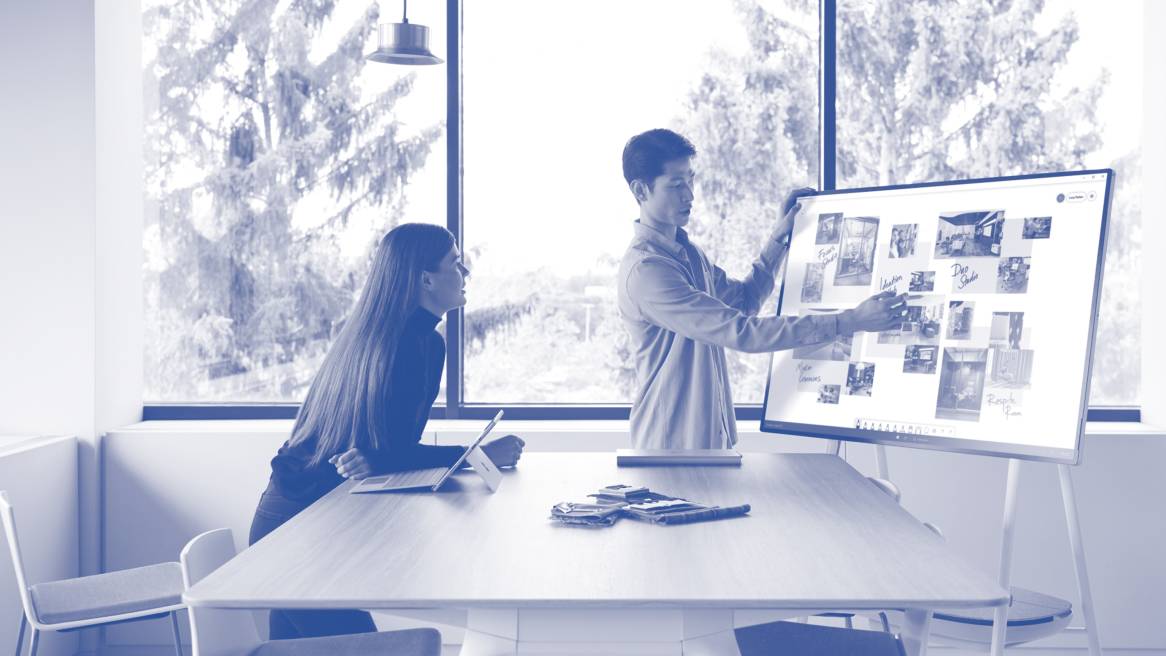The Science of Collaboration (Full Story)
How the body activates the brain and makes ideas better
Ask people where they get their best ideas and you’re sure to hear them say, when I’m going for a run,” “walking in nature,” or the ubiquitous “in the shower.” But how often do you hear someone say their best ideas come while sitting in a conference room at work? Not likely. Ironically, organizations are in dire need of good ideas as they struggle to thrive and grow, yet the typical places they provide for teams to work together and solve problems are more likely to cause people to zone out and disengage than create something novel and life changing.
We’ve all been in those meetings: You come into a conference room, sit in a row along either side of a table (where you can’t easily make eye contact with everyone), and a leader steers the conversation. Standing up would feel weird unless you’re the one presenting, so you stay seated in a comfy chair and pretty soon you notice people checking email and checking out.
Read Fuel Better Ideas: Get Active for a summary on The Science of Collaboration. Plus, new product solutions from Steelcase and Microsoft that make collaboration easier.
Physical movement, postures and gestures impact how we think and feel. As cognitive scientist and now president of Barnard College Sian Beillock says, “The human body is not just a passive device carrying out messages sent by the brain, but rather an integral part of how we think and make decisions.” In her book, “How The Body Knows Its Mind,” Beillock argues that our bodies “hack” our brains and movement positively affects our thoughts and decisions. So, why then do we often create work environments that subtly encourage passive postures and behaviors?
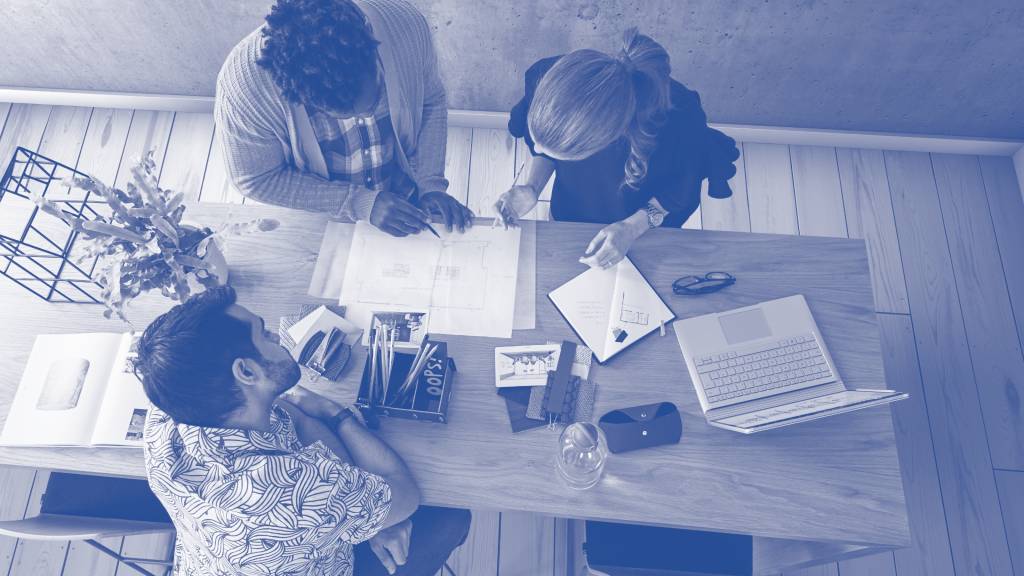
For example, why don’t more collaboration spaces promote perching? Whether half-sitting on a stool, a rail, the back of a chair or the arm of a couch, people who perch will collaboratively generate more ideas than those sitting in chairs. Settling back in a chair causes people to stay settled in their own ideas and react negatively to those of others. In other words, there’s a clear, observable correlation between what people’s bodies experience and what’s happening in their minds. So, in any environment where idea generation is supposed to occur, a perch is a good option to have, promoting an open mind, easy movement and active interaction.
“Perching allows you to come together cognitively and emotionally but not be overly tethered to your position physically or your position on any idea,” explains Frank Graziano, one of the Steelcase WorkSpace Futures researchers who has been studying the impact of environment for decades. But, despite this insight, most organizations are not leveraging the physical environment’s potential to provide people with what they really need and want to do their best work.
Meeting is not collaborating
“I think one of the biggest misconceptions people have about collaboration is that they define it as communication,” observes Donna Flynn, Steelcase vice president of WorkSpace Futures. “Meetings happen — many meetings happen — and very frequently there’s not a lot of valuable output because the bulk of the time is spent communicating about a problem rather than actively solving it.”
Teamwork has become the new norm and people working in offices spend more time with others than working individually, according to a recent Steelcase survey of more than 3,000 people in North America, Europe and Asia. The vast majority of respondents (97 percent) feel collaboration is important to their work and 90 percent believe it is the way to generate better ideas.
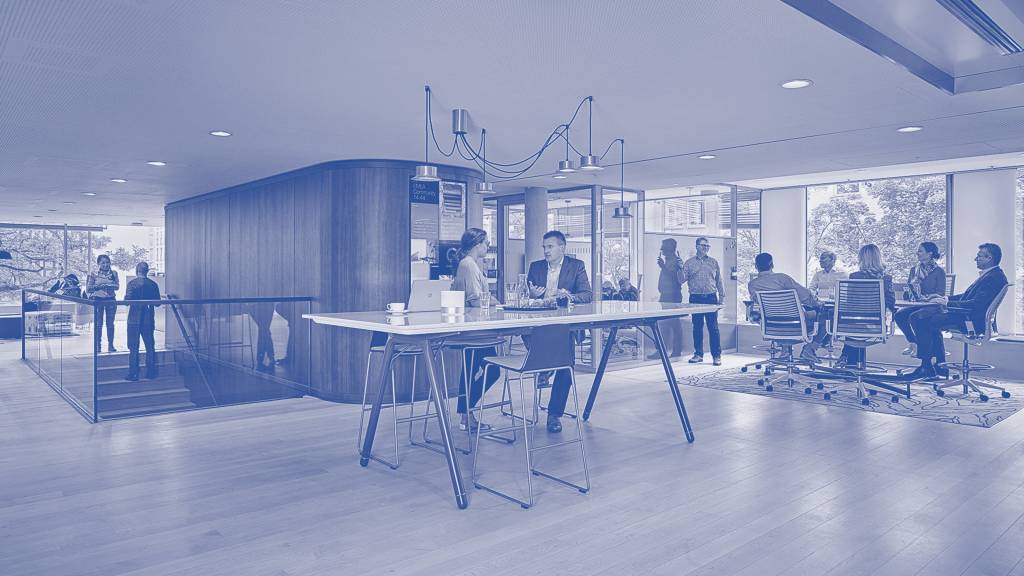
A lot of meetings happening today are about sharing information (informative collaboration) and evaluative activities such as feedback sessions, work reviews and executive reviews, which are important forms of collaboration. But the most challenging form of collaboration is generative — it leads to new ideas and fuels innovation, and rarely happens in typical meeting settings. At its best and most creative, collaboration is active and dynamic, versus passive and sedentary. “Our brains and bodies need to move to be creative,” emphasizes Flynn.
It’s not your fault
As organizations focus on collaboration as a means to innovation, people face some very real barriers. Most of them (70 percent) are still trying to collaborate in those traditional conference rooms that suck the oxygen out of creativity. These spaces are usually enclosed (75 percent) and the large majority of these collaboration sessions are scheduled (81 percent) versus spontaneous. More often than not, collaboration technologies to display information and ideas are non-existent. Expecting people to collaborate in environments like this is like expecting someone to dance in a straightjacket — impossible to do well.
“Organizations need to get better at designing spaces that help people come together to create highly impactful outcomes,” says Flynn. “Right now, there’s a lot of less-than-effective time spent together. If we can help reframe what collaboration is and how to make it really impactful with the right tools, spaces and practices, everyone will benefit — the individual, the team and the business.”
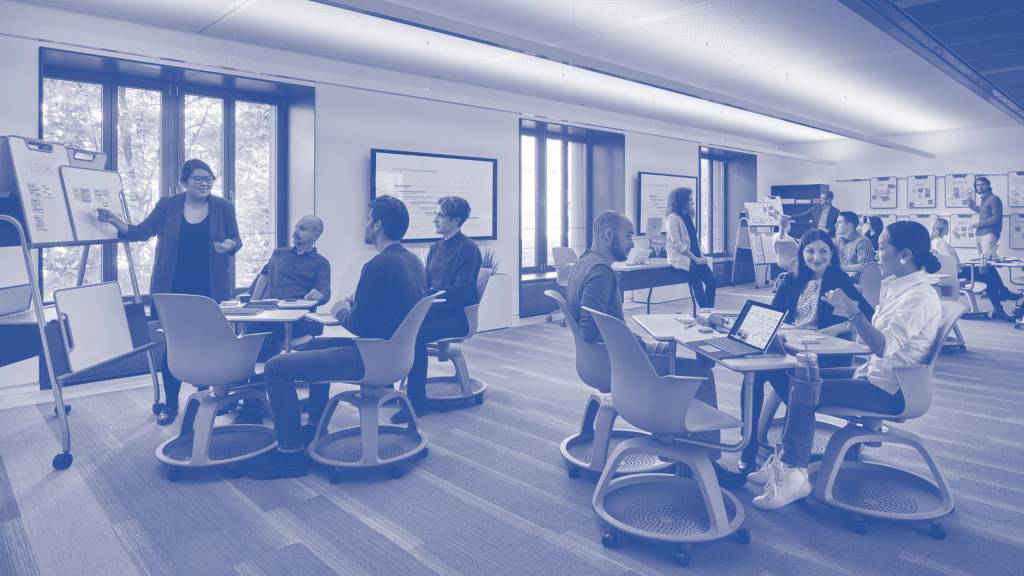
Active learning inspires active collaboration
Organizations that innovate consistently build cultures that nurture learning as a key behavior—teams are encouraged to try new ideas, prototype concepts, learn what works, what doesn’t and then iterate. If learning plays such a pivotal role in innovation, it makes sense to look at new developments in learning environments to understand if those concepts could be applied to work environments.
Active learning theory recognized that traditional classrooms designed in static rows were not keeping pace with the ways students need to learn in the 21st century. Steelcase education researchers explored how to design learning environments that adapt to diverse modes of learning and encourage students to participate more actively. In active learning environments instructors and students can easily rearrange their spaces to support small group work, large group discussions or individual learning. Unlike traditional classrooms, students can move throughout the room as needed, and interact with their instructors and classmates. This is a paradigm shift for some educators, but learning outcomes are soaring.
As the empirical evidence accumulates, methods such as active and embodied learning — that recognize the link between body, mind and environment — have rapidly become classroom norms, replacing traditional approaches where students sit and passively receive information from their teachers at the front of the room. One embodied learning study involved middle school students studying gravity and planetary motion using an immersive, whole-body interactive simulation. When compared to other students who used a desktop version of the same simulation, the results were clear — using the body to enact concepts and experience critical ideas lead to significant learning gains, higher levels of engagement and more positive attitudes toward the topic.
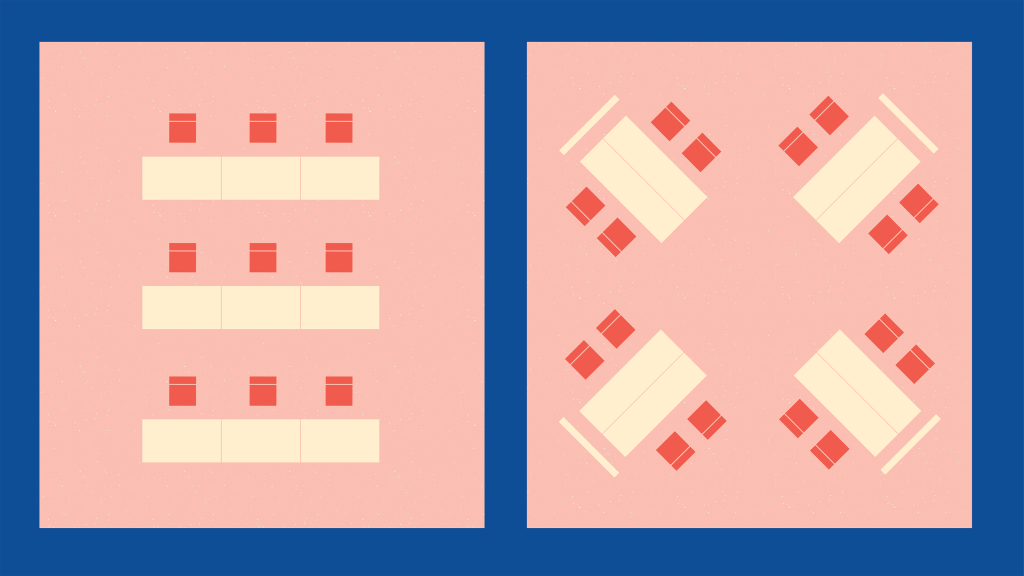
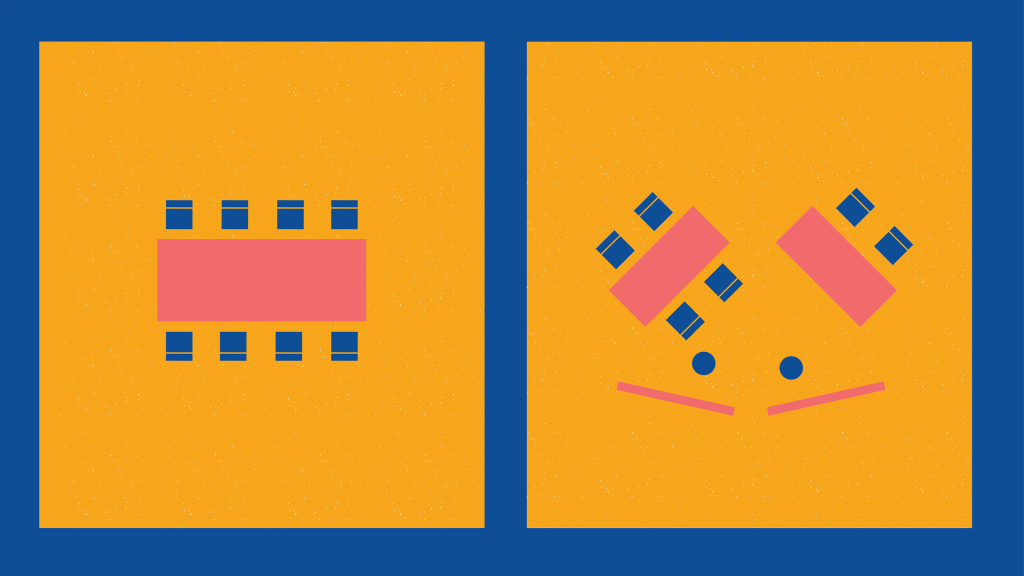
These findings from education research inspired the concept of active collaboration. Just as active learning changed education, active collaboration has the potential to transform work. It is all about designing spaces that encourage people at work to move more, get out of passive behaviors and become more physically and emotionally engaged in the creative process. For example, behaviors such as standing side-by-side encourage “thinking together.” Displaying ideas on boards or collaboration devices invites others to build on those ideas. Making sure everyone has equal access to express their thoughts fosters diversity of thinking and leads to better outcomes.
These behaviors can be nurtured in the workplace by designing spaces to promote:
- Active postures, such as perching, standing and moving;
- Active use of both analog and large-scale collaboration technology to physically connect with content; and
- Equal participation among teammates by breaking down hierarchical structures and leveraging technology to include remote participants more fully.
Why move?
Changing postures and less sitting translates into more physical, mental and emotional engagement in the problem-solving process. Perching or standing signals active engagement and participation, while providing for a variety of postures in a collaborative space assures individuals can move through the full range of team dynamics, from idea generation to critique and reflection, to releasing tension and renewing energy.
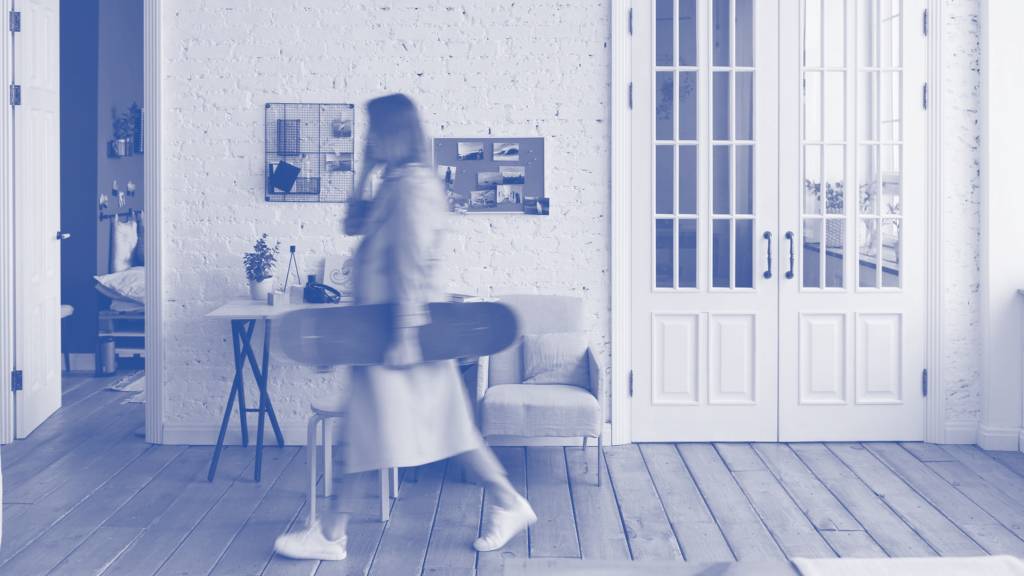
Movement is important for generative collaboration because “we negotiate the value of ideas through our physical proximity to how and where they’re expressed, which controls our ability to build on ideas and collectively create something new,” notes Graziano. Movement assures team members can be close to each other as well as to whiteboards and technologies that array and aggregate their ideas. Even pacing around the room has been shown to increase creativity, according to Beilock. “This fosters more fluid turn taking and sharing in the construction of an idea,” explains Graziano.
“What you want to achieve is a fluid environment, which creates a more open mindset,” says Graziano. “Visible information forms its own community as a representation of its authors and it becomes usable in knowable space. You’re not owned by your chair, instead you’re sharing your ideas. And that becomes a very different experience.”
Collaboration is often described as a meeting of the minds. Yet, we also frequently use action-oriented metaphors to describe our thought processes — sorting through ideas, getting our thoughts straight, pulling concepts apart, weighing the pros and cons, etc. This habit had led some researchers, including the Swiss child psychologist Jean Piaget (1896-1980), to suggest that thought is fundamentally internalized action. Children learn, he said, by doing.
As neuroscientists continue to learn about brain functioning, it’s clearer than ever that our bodies and brains function interdependently. John J. Ratey, M.D. and associate clinical professor of psychiatry at Harvard Medical School, and Beilock, are among a growing number of experts who have presented scientific evidence that movement helps us think and feel better. Even just standing up or performing small movements pumps fresh blood and oxygen to our brains, triggering the release of chemicals like endorphins and dopamine, which improve mood and memory and also play a role in creativity by stimulating the brain to forge new neural pathways versus focusing on what it already knows. This means movement can have an immediate effect on how quickly an insight is reached.
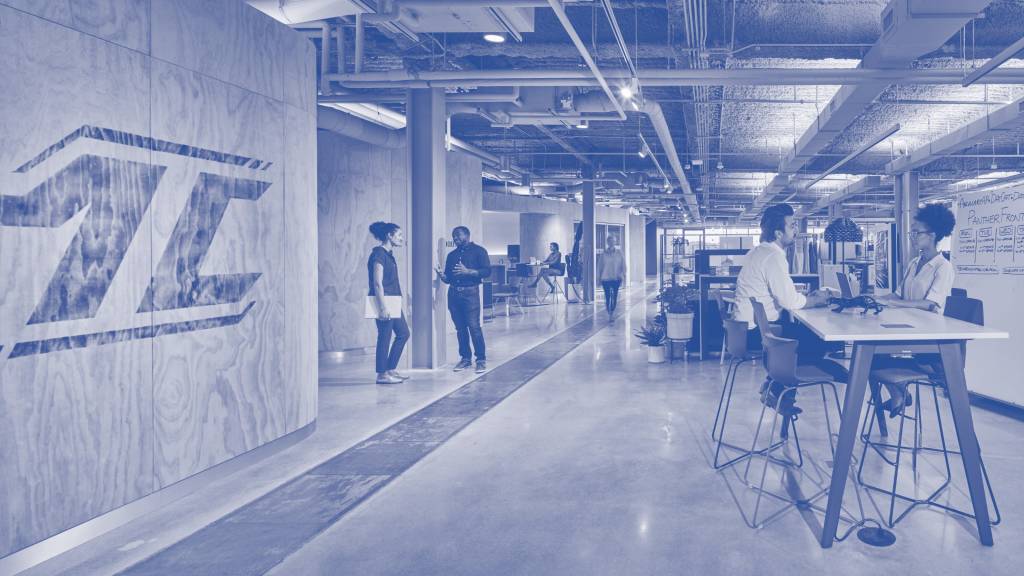
Studies conducted at the University of Illinois a decade ago were reportedly the first to show a person’s ability to solve a problem can be influenced by how he or she moves. Specifically, swinging their arms helped participants solve a problem whose solution involved swinging strings, demonstrating that the brain can use body cues to help understand and solve complex problems. According to the lead researcher Alejandro Lleras, “… actions influence thought and, furthermore, … can implicitly guide people toward insight by directing their actions.” Another study at the University of Illinois showed that physical movements can aid learning and memory as well as change a person’s perceptions or attitudes toward information.
Studies at Stanford University have investigated how walking enhances creative ideation. The overwhelming majority of participants in three experiments were more creative while walking than sitting. In fact, walking increased their creative output by an average of 60 percent. Some researchers suggest that gesturing can enhance our ability to learn and change thought by grounding it in action. As Graziano explains, “Gestures connect content across media to develop new concepts and develop a shared mind.”
Conversely, sitting slows brain activity. In as little as 30 minutes, sitting can lead to foggy thinking and becoming more easily distracted. That’s especially bad news for the hard work of creative collaboration, which places heavy demands on the cerebral cortex, where analysis, critical thinking and problem solving are centered. Because the cortex is an energy guzzler, movement is key to keeping our brains activated and our creative thinking aroused. As John Medina, author of “Brain Rules” expresses it, physical activity is “cognitive candy” — it makes us more energized, engaged and focused.
The Stanford d.school, which focuses on innovation and creativity, explored how posture and movement impacts generative collaboration. Reported in the book “Make Space” by Scott Doorley and Scott Witthoft, the study observed participants collaborating in four distinctly different prototype spaces. One space clustered them in straight-backed chairs around a table. In another, they leaned back into soft couches facing each other in a typical lounge setting. Another prototype was an empty, open space flanked by perches, the only seating option available. The fourth was dubbed “The Sandbox” — a low box with a padded interior where participants could sit low and close to each other.
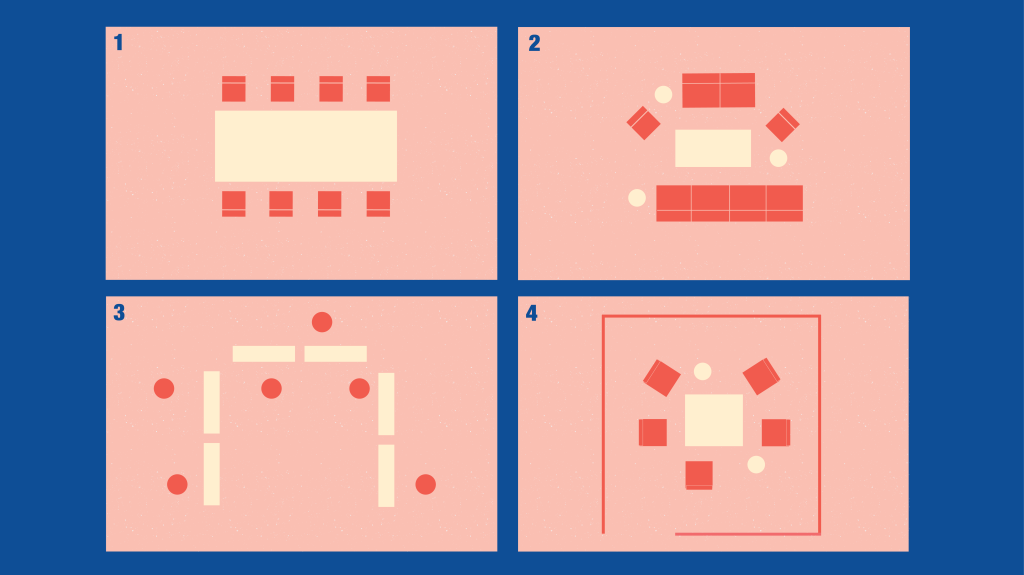
To the surprise of the researchers, the comfort, closeness and informality of the low seating in “The Sandbox” made it hard to get up to share a thought, and the intimacy came across as forced and uncomfortable. The participants seated on sofas not only settled in physically, but began to critique ideas more than build on them. In contrast, the space with perches encouraged active, upright postures. Participants were free to stand and move around. Energy was high and the interplay was lively, resulting in more and better ideas than in the other three prototypes. Doorley and Witthoft’s conclusion? Posture does indeed have “a profound effect” on behavior and idea generation. “Through simple prototyping with postures as a focus, we found that even the slightest attention toward posture — standing versus sitting, for example — can greatly amplify the potential of design collaboration.”
Equal participation
The perception of working collectively can supercharge performance, according to a study reported in The Journal of Experimental Social Psychology. Participants who were primed to work collectively stuck to their task 64 percent longer than their solitary peers, and they also reported higher engagement, less fatigue and higher success.
In the best collaboration experiences, everyone has an equal voice, equal opportunities to actively contribute ideas and equal access to where the team’s ideas congregate, whether it’s a digital or analog display. Although analog tools are more prevalent, recent studies at the Beckman Institute for Advanced Science and Technology at the University of Illinois have indicated when technology is used as an interaction tool, it can improve problem-solving as well as strengthen individuals’ identification with the content and their confidence in their ability to address problems.
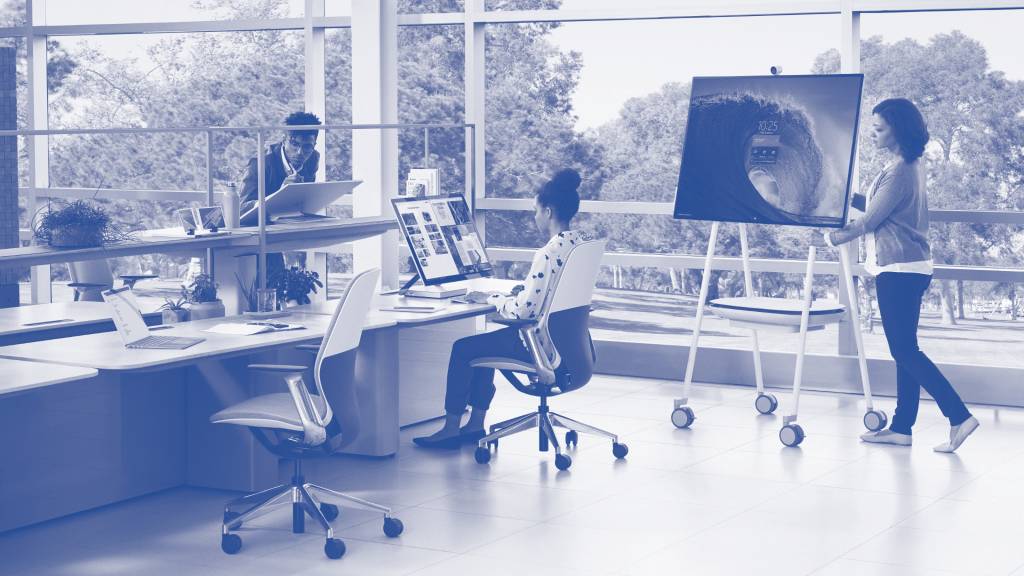
Of course, equal participation is much more challenging when teams are distributed versus co-located, and more teams than ever are facing that challenge. “It’s really hard when you’re the only person who’s not in the room,” reports Flynn, who collaborates virtually about 60 percent of the time. “Even if you have a lot to say and everyone knows that you do, our brains are wired to connect with the people we’re sitting next to.” Intentionally making space in the conversation for people who aren’t in the room is critically important. Having team protocols and the right technologies play an important role in closing the distance gap.
Designing for active collaboration
The vital relationship between physical activity, creativity and collaboration can be translated into thoughtfully-designed places that bring people, place and technology together so teams engage more deeply and generate more and better ideas, faster.
The Steelcase Applications Design Studio offers these principles to create spaces for active collaboration:
Encourage movement
- Use light-scale, light-weight furniture to allow fluid movement; allow teams to feel empowered to take over the space and create a space that best suits their needs.
- Provide ample circulation space for comfortable proximity between team members and technology.
- Design for physical and emotional comfort through posture options and comfortable proximity to other people (eye-to-eye) and content sources. Consider posture relative to the work mode—i.e. standing height for generative meetings so people can easily flow between work surfaces and interaction with wall-integrated technology.
- Provide seating that supports upright postures such as firm-sit lounge or standing/ perching postures.
- Combine furniture + technology that encourage visual exploration, experimentation, and equal contribution by all members of a team; when pairing large-scale technology with lounge settings, provide ample space for proper viewing and circulation.
Encourage equal participation
- Provide co-creation tools, such as large-scale collaboration devices, that allow everyone to contribute to and interact with content.
- Integrate technologies that help speed the visualization process and offer interactive ways to evaluate ideas together.
- Support making ideas visible and persistence of information by leveraging vertical planes with postable, writable surfaces adjacent to technology to guide the creative process.
- Enable privacy and control over the environment to provide a “safe haven” where new ideas can incubate.
Create an ambient connection to the space
- Build a welcoming environment and personal connection to space with authentic design elements, artifacts and materiality that inspire team members.
- Design spaces that encourage people to visually explore multiple solutions by experimentation and engagement with integrated technology.

